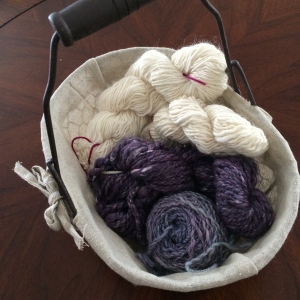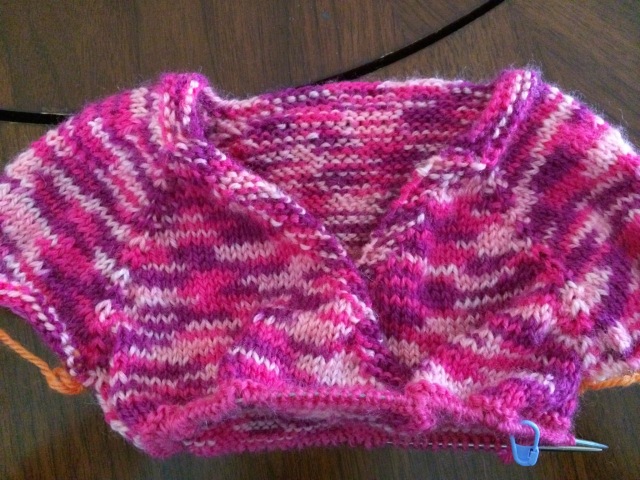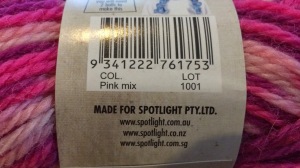While there are many guides to the basic crochet stitches, it can be harder to track down some of the more interesting techniques that can add the little extra polish to a project. Craft learning has really brought home to me the concept of ‘you don’t know what you don’t know’. Without even knowing that a term or technique exists your only hope of learning it is to discover it by accident or by reading some technical books that happen to have it. So, in the hope of helping someone else discover a new treat, here are my 5 favourite crochet ‘tricks’.
1. Foundation Stitches
Even in the few years that I’ve been crocheting these have become noticabely more widely known. Basically, instead of chaining and then working your first row of stitches back over the chain you create the chain and the first row at the same time. The advantages of this technique are that
- the starting edge is stretchier,
- you don’t need to worry about your chain being too long or too short
- and the chain can’t get twisted.
The video below shows the technique used in a row of single crochet, but it can be used for any starting stitch with some tweaking. It made a lot more sense to me once I got that I first make the chain and then I make the actual stitch, once you get that you can work out how to work a row of foundation stitches in pattern.
2. Continuous Motifs
This is a technique I first stumbled across in Edie Eckman’s Connect the Shapes Crochet  Motifs and it’s a way of making motifs without ever breaking the yarn. It’s like a super upgraded version of join as you go (another great trick). It’s very hard to explain, especially without a full photo/video tutorial, but basically you ‘replace’ some of the stitches with chains as a way to sneak in the middle of the motif, then you work as normal until you get back to your chain where you do your slip stitch join. But! Then instead of chaining up for the next row you slip stitch back up your chain to start the next row. Adjacent motifs are picked up with one of the standard join-as-you-go methods. There are two tricks that make this continuous technique work:
Motifs and it’s a way of making motifs without ever breaking the yarn. It’s like a super upgraded version of join as you go (another great trick). It’s very hard to explain, especially without a full photo/video tutorial, but basically you ‘replace’ some of the stitches with chains as a way to sneak in the middle of the motif, then you work as normal until you get back to your chain where you do your slip stitch join. But! Then instead of chaining up for the next row you slip stitch back up your chain to start the next row. Adjacent motifs are picked up with one of the standard join-as-you-go methods. There are two tricks that make this continuous technique work:
- on the last slip stitch up the top you have to do a cross over slip stitch, it’s hard to explain but you keep the working yarn to the back and put your hook on the left most loop of the chain and work you slip stitch, this leaves you on the left hand side of the chain ready to keep working
- you need to leave some of the last row of each motif unworked, you then use these as a path back to the beginning, think of those brain teaser puzzles where you have to make shape connecting the dots without retracing a line.
A big limitation of this technique is that it really only works in one colour. The need to leave a pathway back means that using a variegated or colour change yarn will leave that section the wrong colour. Changing ‘manually’ to a differently coloured yarn will increase the number of ends per square, which defeats the whole point. But for single colour pieces this technique is a real time saver. It’s also such an uncommon technique that this was the closest to a tutorial that I could find: http://fionitta.com/2013/crochet-lillipop-rug
3. Using Elastic as a Foundation Chain
One of the challenges of crochet is getting a fabric that can stretch. There are tricks (bp/fp or bl sc ribbing, the above mentioned foundation stitches) but they’re still not that stretchy, just stretchier. This can be a drawback for working hat brims, sock cuffs and tight fit headbands. Then one day a friend of mine gave me crocheted hat she’d bought at a market; there was no foundation chain, the first row was worked over a colour coordinated piece of elastic, and I thought to myself that’s bloody brilliant. Now, the total stretchiness is still limited by the main fabric, but crowding up stitches or having a few rows of a lacy type fabric can go a long way. The same technique is used to make this hair-tie, now how’s that for stretchy!
4. Magic Circle
The magic loop, or magic ring is a way of starting a crochet circle that doesn’t have a hole in the middle. Knitters take note: this is different from the knitting technique known as magic loop but is the same as the start of Emily Ocker’s Circular Cast On. Basically you make an adjustable loop, work your first row into it and then pull it tight to close it. It’s fantastic for toys and top down hats.
5. Invisible Decrease
This is another technique that avoids holes and is essential learning for making toys (at least in my opinion). Rather than working the usual sc2tog you thread you hook through the front loops only of the two stitches being joined (both form front to back, it takes some finagalling) and then finish the stitch as for a normal sc.
So there we go, 5 of my favourite things I’ve found in the deeper seas of the crochet world. If you’re thirsty for more of them check out Eddie Eckman’s Crochet Answer Book and for toy (amigurumi) tips the illustrious June Gilbank of Planet June is hard to beat.



















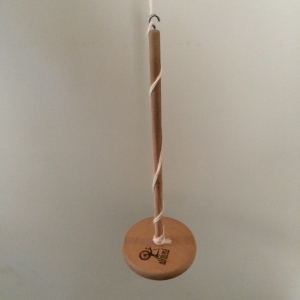

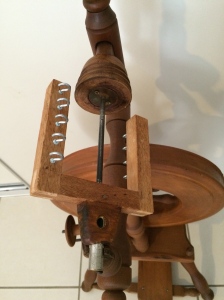 That mismatched bit is called the flyer and it spins superfast (good) and then jumps off (bad). The general advice to new spinners (that I heard later) is to avoid handmade or discontinued wheels as replacement parts are hard to find. It’s good advice.
That mismatched bit is called the flyer and it spins superfast (good) and then jumps off (bad). The general advice to new spinners (that I heard later) is to avoid handmade or discontinued wheels as replacement parts are hard to find. It’s good advice.

